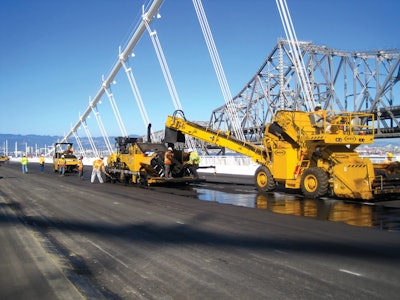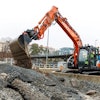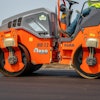
Unless you lived under a rock last summer, you undoubtedly heard about the final stages of reconstruction on the new Bay Bridge in San Francisco. Under a tight deadline, milling and paving crews worked around the clock the week before Labor Day to complete work on the East Span of the bridge on time. The self-anchored suspension (SAS) span of the bridge underwent a “seismic retrofit,” and while the engineering received much of the attention, there also were significant changes to the asphalt on the bridge.
The original Bay Bridge opened in 1936 and carried 9 million cars that first year. Today, the bridge has over 100 million travelers in a year, so it was important to improve the bridge and ensure it could sustain itself for the future. The SAS consisted of two decks, 2,280 feet long by 79 feet wide. And while the bridge opened on September 3rd, 2013 on time after multiple crews worked around the clock to complete the paving work in just about 20 days, 10 days per deck, this revolutionary project was a challenge for all involved.
Challenging project
O.C. Jones & Sons Inc., of Berkeley, Calif., paved large portions of the bridge. Jones has a long history of successfully completing difficult projects—on time and on budget. Past projects include paving a portion of the bridge in 1976, and toll plaza demolition, reconstruction and paving work during the last Bay Bridge shutdown in 2011.
O.C. Jones essentially took on two different projects as part of the bridge work. First was placement of the specialized epoxy on the SAS portion of the new bridge.
The second project was the new transitional paving on the Oakland touchdown side of the new bridge. That area stretched 1,289 m (4,229 ft.) from beyond the toll plaza to the new bridge approach. The California Department of Transportation (Caltrans) wanted a new surface on the approach, and also corrections to grade and slope.
Placing epoxy
Two 25 mm (1 in.) lifts of Epoxy Asphalt Concrete (EAC) were placed on the eastbound and westbound lanes of the Bay Bridge’s new SAS span. The epoxy was chosen because of its extreme durability, tractive benefits and lighter weight.
“The material used was quite unique, and presented some interesting challenges not normally seen with conventional asphalt concrete,” said Kelly Kolander, president and CEO of O.C. Jones. “This is the only time this material will be placed in the U.S. this year.”
The EAC is essentially a 9 mm (3/8 in.) mix that uses a two-part epoxy. One part is blended with AR 4000 paving oil. It is combined with a specialized dry aggregate and a separate epoxy resin, and mixed in a pug mill.
The resultant EAC is then placed atop a two-part epoxy bond coat. That bond coat was applied to both the steel bridge deck and the first lift of EAC.
The bond coat needed to be applied at a high application rate, using both a robotic device and spray wands. The epoxy products, as well as the technical support, were provided by Chemco Systems of Redwood City, Calif.
“The EAC is significantly different from conventional AC in that once the material is produced from the batch plant, a chemical reaction begins as it is hauled to the project site,” Project Manager Bill Jensen stated. “Due to this chemical reaction and extremely tight time and temperature requirements, consistency in travel time for the haul trucks and in the production of the material at the plant were crucial.”
So crucial was timing that O.C. Jones was able to secure a haul route to the site with the help of the Californian Highway Patrol and Caltrans. Those organizations worked to minimize traffic disruptions.
Once the material arrived, it was again tested before it could be placed through the paver. The window for mix placement was extremely tight and closely monitored by testing personnel to ensure project specifications were met. The material then was approved for placement on the bridge deck.
RTV a perfect fit
The process had another complication: Trucks and other machines were not allowed to travel on the paving lane after the bond coat had been applied. That meant the material had to be loaded from the side.
This was one of the reasons that O.C. Jones utilized a Weiler E1250A Remixing Transfer Vehicle on the job. The E1250A’s conveyor accommodates offset paving, enabling trucks and the RTV to stay off the paving base and the bond coat.
In addition, the E1250A does not have storage capacity, helping the machine weigh 23,000 kg (51,000 lbs.) less than an RTV with storage—an important factor when working on a bridge, where every pound counts.
“Since storage or surge capacity was not required, the Weiler E1250A proved to be the right choice and performed well,” Kolander said.
The material was discharged into a Cat® AP1055E Asphalt Paver, which utilized non-contact averaging skis for enhanced ride quality.
Compaction and rolling patterns were again closely monitored and achieved with Cat CB54 Vibratory Asphalt Compactors and Cat PS150C rubber-tired rollers. The compactors typically made three complete passes, with movement up and back counting as a single pass.
Another unique aspect of the project was the need to thoroughly clean out the RTV and paver after every pass, typically 670 m (2,200 ft.) in length. Unlike conventional AC, EAC is not thermoplastic, and therefore cannot be re-heated.
Once the chemical reaction occurs, the mix remains hard. “This required removing any built-up material in the paver’s auger chamber as well as inside the RTV to avoid cured EAC from falling onto the finished mat,” said O. C. Jones Area Manager Kevin Goddard.
The Second Project
The bridge was shut down over Labor Day weekend as O.C. Jones crews reconstructed the approach area on the Oakland touchdown side.
That portion of the project did not require the placement of EAC. Instead, crews worked with traditional AC mix, as well as an open-graded asphalt cement. About 17,200 metric tons (19,000 U.S. tons) were placed over an area of 93 million m2 (1.1 million ft2.).
Yet that project had its own challenges. Cold planers had to remove mix over much of the area before repaving could begin. So large was the required milling volume that up to seven machines worked continuously for 36 hours.
The leveling was particularly extensive in some areas. The eastbound direction required a large profile correction and required removing asphalt at depths up to 0.9 m (3 ft.).
“Complicated cross-slope corrections, leveling and new construction to tie into the new bridge structure from the existing toll plaza area proved challenging, given the tight time constraints,” said Area Manager Jim Gallagher.
Paving work began at 10 p.m. Wednesday night and continued non-stop until Sunday morning, utilizing one night crew and two daytime crews.
“There was an incredible amount of coordination between the AC plants, grinders, trucking, traffic control and access points,” Jensen said. “Over half of the material placed was required to correct cross slope to aid drainage, establish a new roadway profile, and level uneven pavement, which is all very time-consuming.”
Additionally, the westbound portion goes from five lanes to 20 lanes at the toll plaza, then back down to five lanes.
“It made the joints and lane lines an increased challenge,” Kolander said. “The Cat pavers handle the variable widths very well; our crews really appreciate their versatility.”
Equipment used included Cat AP1055E and 655D asphalt pavers, Cat CB64, CB54 and PS 150C rollers, as well as the Weiler E1250A RTV.
A success
Kolander said the demands on the job left no margin for error, yet O.C. Jones was able to deliver. He credited the Caterpillar and Weiler products for their roles in helping reach a successful conclusion.
“Being such a complicated and specialized paving project, not to mention such a high-profile one, we required high-production, quality equipment and 100 percent uptime,” Kolander said. “Our Cat dealer supports us on a daily basis with our paving needs. We were pleased with the Weiler product as well. It is a well-built machine that performed as advertised.”
All factors had to perform together on this project. “The epoxy is certainly not used very often, but has some great benefits,” Kolander said. “While not as high profile as some of the other portions of the bridge, the paving process represented a significant change as well.”















